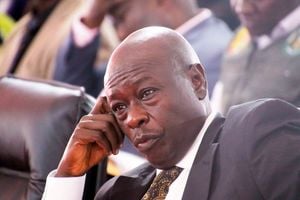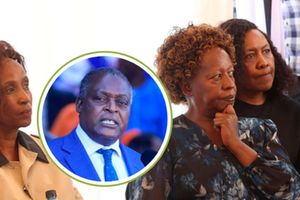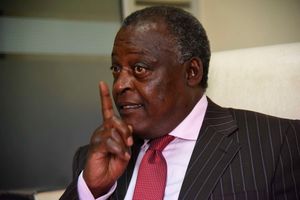
Jaramogi Oginga Odinga (left) and Mzee Jomo Kenyatta. Inset: Members of Patrice Lumumba's family at the Lumumba Institute in Nairobi.
It was December 12, 1964; and a new republic had just been born. Amid the fanfare around a nascent administration, a secret quietly stirred beneath the surface.
Tucked away from the public gaze, in a secluded compound in Ruaraka, a towering sculpture of Congo's martyred prime minister, Patrice Lumumba, stood still. Only one man grasped the full magnitude of the machinations unfolding in its shadow: Jaramogi Oginga Odinga, Kenya's Vice President.
It was his secret.
The school, as reported by the US Ambassador, William Atwood, was financed by Russians after a meeting with Odinga and Joseph Murumbi in early 1964.
Odinga had convinced President Kenyatta that the objects of the Lumumba Trust, which was to manage the institute, was to "establish and maintain a college, university or school" and to "grant scholarships and bursaries".
Named after Patrice Lumumba, the slain Congolese leader, the institute was to "provide courses and arrange seminars and discussions for Kanu workers and officials."
That was the catch, however.
As Atwood later wrote in his book, The Reds and the Blacks (later banned by President Jomo Kenyatta), “the faculty was headed by two Russian professors, one of whom was a KGB agent.”
As President Kenyatta inaugurated the Lumumba Institute, he remained oblivious to its true purpose. Concealed behind the guise of a training ground for Kanu officials, Lumumba Institute was Odinga’s clandestine school for communist ideology.
The trustees of this institute were carefully chosen, the Kapenguria Six, save for the illiterate Kung’u Karumba, who was excluded. Bildad Kaggia, a radical member of the Mau Mau, and key proponent of free land, had been selected as the chairman.
But apart from Kaggia, the rest were nothing more than ornamental figureheads. The true reins of the institute lay firmly in Odinga’s and Kaggia’s grasp.
Odinga had brought in two Russian "lecturers", Mr Alexei Zdravomyslova and Mr Andrei Bogdanov to teach "principles of socialism".
“He also arranged for military training in China and Bulgaria for more than a hundred hand-picked ‘students’”– according to Atwood, and “as Minister of Home Affairs, he was well placed to get them discreetly out of Kenya and back again.”
But according to Odinga, in his autobiography, Not, Yet Uhuru, “The Lumumba Institute was to be the vital centre for the training of party officials who would function at the grassroots level of Kanu party organisation.” More so, it was “to serve as continual reminder to government and administration that they were in office by virtue of the peoples’ decision.”
At the core of Odinga's woes lay the covert machinations of the British. In London, apprehension grew that Odinga might unseat Kenyatta, whether through constitutional means or otherwise, prompting the British to devise a clandestine strategy to undermine him.
Their aim was twofold: to weaken Odinga’s standing and to scare Kenya’s pro-Western political class. Intelligence reports on Odinga; some factual, others fabricated, were discreetly fed to gullible politicians eager to see him ousted. This elaborate propaganda campaign successfully convinced Odinga’s adversaries that he harbored ambitions to overthrow Kenyatta’s government.
On a broader scale, however, the British saw Odinga as a direct threat to their geopolitical interests and wielded the label of communism as a weapon to discredit and isolate him. Lumumba Institute was the entry point.
In Nairobi, Tom Mboya, a consistent adversary of Oginga Odinga and a known ally of the West, received intelligence from American sources. As noted by his biographer David Goldsworthy, one of the "unstated objectives was to undermine Mboya, who was deliberately excluded from the project despite his position as the party's secretary-general."
Lumumba Institute was the last radical project that Kenyatta participated in with Odinga and after that, Goldsworthy argues, Kenyatta asked Mboya to prepare a “definitive documentary statement on Kenya’s guiding political philosophy” as an answer to the scientific socialism propagated under the aegis of Lumumba Institute.
On April 25, 1965, the celebrated Sessional Paper No. 10, African Socialism and its application to planning in Kenya was handed to Kenyatta. Two months earlier, on February 25, 1965, one of the Lumumba Institute insiders, Pio Gama Pinto, had been assassinated.
On March 25, Narok East MP Justus ole Tipis gave notice of a motion urging the government to take control of the Lumumba Institute and place it under the Ministry of Education, "like any other institute." Tipis also called for the appointment of a new board "with no political mandate."
In response, two Lumumba Institute student leaders, David Munyendo (secretary general) and G. Mwitumi (chairman), issued a forceful press statement: "We question why [Tipis] has not moved a similar motion calling for the government to take over bus services or Kenya Breweries."
Behind this clash were the Institute’s lecturers, with Odinga having appointed a trusted ally, Oluande Koduol, as the new registrar. A graduate of India’s Aligarh University, Koduol was an ideal fit for the role. He began by organizing seminars but remained perpetually unsettled.
Pinto’s death jolted the socialists in Kenya – and, in the powerplay, Lumumba Institute was dismissed as the hotbed of communism in Kenya.
On April 8, Lumumba Institute hosted Assistant Minister for Finance, Okello Odongo to deliver a speech that would both test the political climate and lay the foundation for the escalating conflict between Odinga and Mboya. During his speech, Odongo declared: "Uhuru will be meaningless if economic power is not transferred."
Mboya swiftly retaliated with a lengthy article in the local press, targeting both Odongo and Odinga. He called for the institute's closure, marking the beginning of a fierce battle over the influence of Communism in Kenya’s politics.
Odinga’s supporters rallied to prevent the institute from being shut down. Ronald Ngala, the Kilifi South MP, openly demanded that the government either take over the institute or close it entirely.
While Odinga himself did not immediately intervene, his loyal lieutenant, Luke Obok, harshly criticised Ngala, arguing: "If Mr. Ngala is troubled by the presence of a few Russian teachers at the institute, as a true nationalist he should also demand the nationalisation of other institutions in Kenya run by Americans, the British, Germans, and Israelis."
Student leader David Munyendo also defended the Russian instructors, insisting they "were not teaching foreign ideologies. They teach principles..."
So fired were the students of the Lumumba Institute that on July 16, 1965, some 16 days after the first batch of 84 students had graduated, they stormed Kanu headquarters, then at Nairobi’s Mfangano Street, and staged a "coup".
Mboya was replaced with Wanguhu Nganga, one of Lumumba Institute tutors and journalist. The previous day, they had held a secret meeting at Alvares Hotel and agreed on a new Kanu lineup.
According to the late Wanguhu, who on many occasions confessed to this writer, Kenyatta instructed his Attorney General, Mr Charles Njonjo, to have all those implicated in the Lumumba Institute coup punished. In the first case of its kind, Njonjo appeared for the State, which was supported by a record 14 state counsels. The entire Odinga group was jailed.
Behind the scenes was a key Chinese undercover agent, Mr Wang Te Ming, who travelled on a diplomatic passport and masqueraded as a journalist. Ming was once a Chinese volunteer soldier during the Korean War and had risen to the rank of a major.
Another plotter was a South African communist, Mr Hosea Jaffe, a Cape Town University-trained engineer who was teaching mathematics at the Duke of Gloucester School. He was kicked out of Kenya on the orders of Dr Njoroge Mungai just after the coup at Kanu headquarters.
Early enough, according to Atwood, he had come to believe that Kenyatta was not trusting Jaramogi. He later revealed, much to the chagrin of State House insiders, some of his secret talks with Kenyatta on Odinga: “The first indication I had from Kenyatta that he didn’t trust “Jaramogi” was in mid-June, when he called me over to discuss outside financing of Kenya’s politicians.
Before independence, Tom Mboya had been getting help from the AFL-CIO and other Western labour groups to build up Kenya’s trade union movement. Kenyatta wanted to make certain such assistance had now stopped... But what about Odinga’s subsidies from the Chinese and Russians?” He asked. “I know about them,” said Kenyatta. “I’ve already called in their ambassadors and told them to stop.”
On the night of May 25, 1965, Mr Bildad Kaggia drove to the Lumumba Institute and dropped a bombshell – the institute would close on June 20 after the first batch of students graduated.
With the closure of Lumumba Institute, Odinga was now vulnerable and had come under constant attack. He had no substantive docket and was ignored on major matters.
The final showdown came in March 1966, some nine months after the closure of the institute. Mboya, now at the height of his power, put into motion a calculated plan to topple Odinga. While the verbal campaign continued (including an open Odinga-Mboya clash in Parliament on February 15), Mboya planned a Kanu "re-organisation" meeting at Limuru Conference Centre planned to remove Odinga from the party hierarchy by watering down his position as the party’s vice president.
On April 14th, 1966, Odinga resigned after serving less than two years as Kenya’s vice-president. By that time, he had been marginalised, and efforts were underway to render him politically irrelevant. In his letter of resignation, Odinga finally told Kenyatta:
“You have not given any consideration to me as your number 2 in State matters. I have a conscience and this in fact does prick me when I earn public money but with no job to do. I consider this a waste of public money, and I am worried lest the future generation questions my sincerity, when they would learn that I allowed myself to hold a sinecure post in the midst of poverty and misery in our country. With this realization, I cannot continue to hold this position any longer and I hereby tender my resignation.”
With Odinga out of the Kenyatta succession, Mboya did not last long as was subsequently assassinated on July 5, 1969. By then Odinga was struggling to maintain his political party, the Kenya People’s Union, which had been rocked by defections. Odinga’s attempt to capitalise on Mboya’s death and attack Kenyatta directly during the opening of the Russian Hospital led to his detention- and sidelining of his supporters. By the time he managed a comeback, in the 1990s as leader of Ford Kenya he was elderly and more susceptible to manipulation.
Tomorrow:Why Joseph Murumbi resigned as Kenyatta’s Vice-President











